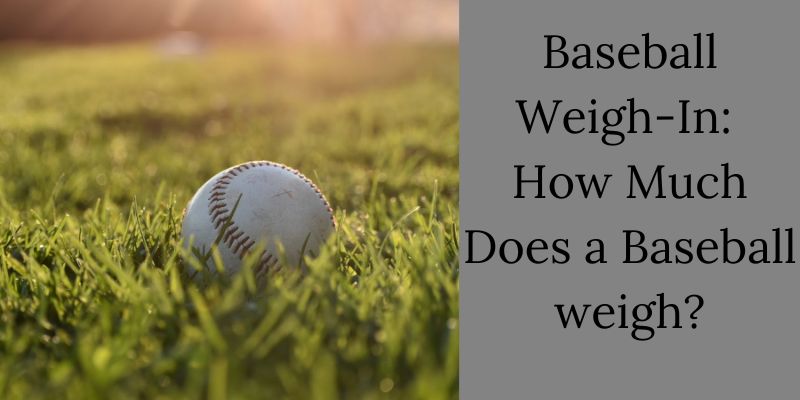At the heart of America’s favorite pastime is a small, seemingly insignificant object: the baseball.
With its familiar leather cover and tightly packed cork and rubber core, this humble ball has played an integral role in major league baseball for over a century. But how much does a baseball ball weigh?
Despite its size, the weight of a baseball is a topic that has sparked much debate over the years. Some experts believe that the weight of a baseball may have played a significant role in shifting the balance of power between teams in the so-called “dead ball” and “live ball” eras.
While there is no definitive answer to this question, there is no doubt that baseball fans everywhere will continue to weigh in on the topic for years to come.
Whether you’re a die-hard fan or just getting started, one thing is clear: the weight of a baseball has long been and continues to be an essential part of America’s pastime.
This blog post explores the fascinating topic of baseball weight, examining how it has evolved over the years and its role in the game today.
What Is a Baseball Ball?
A baseball is a ball used in the sport of baseball. It is about the size of a fist and is usually made of leather or synthetic. The ball has a raised seam that helps the pitcher grip the ball and throw it with spin.
The spin makes the ball curve as it moves through the air. The ball also has a cork or rubber center, making it bounce when it hits the ground. A baseball game is played with two teams of nine players each.
The teams hit the ball and try to score runs by running around bases and touching home plate. The team that scores the most runs in nine innings wins the game.
How Much Does a Baseball Weigh?
The weight of a baseball is specified by the Official Rules of Major League Baseball. A ballpark estimate puts the weight of a baseball at about 6 ounces. Still, it weighs 5 to 5.25 ounces.
This weight has remained constant throughout the years, even with the recent increase in home run hitting. Cardinals pitcher Cory Lidle once remarked, “It doesn’t seem like it would make that big of a difference, but it does.” And he should know that even a tiny difference in weight can significantly impact a pitch.
The weight of a baseball is vital because it affects how far the ball will travel when hit. A heavier ball will not travel as far as a lighter ball. If a baseball’s weight increases, fewer home runs will hit in a season.
The History of Baseball Ball Changes and Its Weight
For as long as baseball has been around, baseball has undergone many changes. In the early days of the sport, balls were much larger and heavier than they are today. They were also made of different materials, such as cork, rubber, and milkweed fibers.
The weight of the ball has also varied over time, with heavier balls being used in the late 1800s and early 1900s to help increase hitting distances. Recently, the ball’s weight has been reduced to help increase bat speed and improve safety for hitters.
While the size and weight of the baseball have changed throughout history, its basic shape has remained relatively unchanged. The size of the stitches on a baseball can also tell us a lot about its history.
Early baseballs had huge stitches, making them easier to grip but more likely to come apart. As you can see, the history of baseball is full of fascinating changes.
Each change was made to improve the game, and today’s baseball is a direct result of centuries of experimentation and innovation.
How Were the Early Days of Baseball (Ball)?
In the early days of baseball, the balls were made from a rubber core, which was melted down from old shoes. The rubber was then covered in yarn and leather, and the whole ball was sewn together.
In rare cases, fish eyeballs were used as the ball’s core. Throughout the game, pitchers would use their custom-made balls, weakening and unraveling as the game went on.
This made for a very different game than what we see today! The balls were often not very round, and they would get softer and harder to control as the game progressed. It was a very different game back then, but it was just as exciting to watch!
What Is the Dead Ball Era in Baseball?
In baseball, the “Dead Ball Era” refers to the period between 1900 and 1919 when scoring was lower than usual.
This was due to several factors:
- Different players use softer balls
- Each player produces their ball
- Pitchers who specialized in throwing accurate but not overly fast pitches
- Outfielders who used large gloves to catch fly balls.
The dead ball era ended when Babe Ruth popularized the home run with his outstanding hitting performance in 1920. This was possible due to a ball produced by a pitcher, A.G. Spalding, the ball was made with a rubber core, and the National League accepted it for its official games.
As a result of Ruth’s influence, the following years saw a dramatic increase in scoring as hitters began to swing for the fences more often.
While some purists mourned the passing of the dead ball era, others welcomed the new era of power hitting with open arms. Either way, there’s no denying that Babe Ruth left a lasting mark on baseball.
What Is the Live Ball Era?
The Live Ball Era in baseball is often considered to have begun in 1920, when baseball executives, looking for ways to increase scoring rates and attendance, implemented a series of rule changes.
Among the most important of these changes was replacing the ball at the slightest sign of wear which makes the ball more accessible for the hitter to see. This drove up scoring rates and made home runs more common.
In 1920, a pitcher, A.G. Spalding, designed a new baseball using Australian wool. A cork center and rubber coating were significant improvements, which made the ball more durable.
In addition, the National League abolished spitball, a pitch that had been used extensively since the early days of baseball. As a result of these changes, scoring rates increased significantly, and home run totals skyrocketed.
The Live Ball Era ended in 1934 when baseball executives decided to standardize the size and weight of balls. However, the impact of the Live Ball Era remains evident today in the high scores, and the long ball hitting is still a hallmark of the game.
What Is the World War II Cork Ball?
Many materials were in short supply during World War II, including rubber. This made it difficult to manufacture baseballs, as rubber was an essential component. As a result, alternative materials had to be used, including cork.
The first cork ball was accidentally created in an East St. Louis tavern. A man who had been drinking pulled the cork bung from a beer barrel and taped it up. He then threw it to a fellow drinker, who attempted to hit it with a broomstick.
Surprisingly, the cork ball worked well and bounced off the floor without damage. The popularity of the cork ball quickly spread, and soon they were being used in casual games all over the country.
Because there were no base runners and no bases, these games were quite different from traditional baseball, but they were still great fun.
What Is the After World War II – Present Era?
After World War II ended, not much changed baseball-wise. Players were still using the same horsehide balls they had used before the era of world war. It wasn’t until the 1970s that things started to change.
Cowhide replaced horsehide as the material of choice for baseballs; this change led to a more exciting baseball brand; today, the game is more popular than ever. Thanks to these innovations, the present era of baseball is a fascinating time to be a fan of baseball.
Specifications of MLB Baseball Ball (MLB Rulebook)
The MLB Rulebook contains the official specifications for the baseball used during Major League Baseball games. According to the Rulebook, the ball must have a diameter of between 2.86 and 2.94 inches and weigh between 5 and 5.25 ounces.
The ball must be made of “Yarn wound around a small core of cork, rubber or similar material.” The ball’s cover must be made of “horsehide or cowhide,” and the stitching must be made of “wool, cotton, linen, or silk thread.”
The ball must also be “constructed in such a way that it will retain its shape and not come apart during play.” These specifications help to ensure that the baseball used during MLB games is of the highest quality and will not cause any problems during play.
Different Types of Baseballs
Each type of baseball is designed for a specific purpose, whether for training or competitive play. Here are just a few of the different types of baseballs that you might encounter:
- Training baseballs are typically smaller and lighter than standard balls, making them easier to hit. They are also usually brightly colored to be more visible to hitters. Training baseballs are often used in batting cages or during group practice sessions.
- Competition baseballs: Competition baseballs are larger and heavier than training balls, making them more challenging to hit. They are also typically whiter in color, making them more visible to pitchers. Competition baseballs are used in official games and tournaments.
- Softballs: Softballs are similar to training balls in size and weight but softer and have a lower bounce. This makes them easier to hit and more difficult to field. Softballs are often used in practice sessions or informal games.
Whether you’re a beginner or a seasoned pro, there’s a type of baseball that’s right for you. So get out there and start playing the great American game!
What Is the Inside of a Baseball Made Of?
At first glance, a baseball may not look like much. It’s just a small, round object, after all. But if you take a closer look, you’ll see that a baseball is a complex and fascinating piece of equipment. So, what exactly is the inside of a baseball made of?
The core of a baseball is typically made of cork mixed with rubber. This provides the ball with its bounciness. The outer layer is made of tightly wound yarn encased in leather.
The leather gives the ball its shape and helps protect the string from wear and tear. Finally, the ball is covered with a layer of stitches, which hold everything together and help the ball keep its shape when a bat hits it.
So there you have it! The next time you watch a league baseball game, take a closer look at the ball and appreciate all the hard work that went into making it.
How Are MLB Baseballs Made?
MLB baseballs are made with a pill of cork molded with rubber at their center, wrapped in three layers of wool yarn. The two figure 8 patterns of cowhide are then hand-sewn together with 88 inches of red waxed thread.
One hundred eight stitches are needed to complete the process, and the result is a ball that weighs 5.125 ounces and has a circumference of 9.25 inches.
Though the materials and construction of MLB baseballs have remained unchanged for over a hundred years, the manufacturing process continually evolves to ensure that each ball meets the exacting standards the league sets.
A team of experts scrutinizes every batch of baseball before it can be used in an official game, ensuring that each one meets the highest quality standards. MLB baseballs are some of the best in the world thanks to this commitment to excellence.
FAQ
How Much Does a MLB Baseball Weigh?
A major league baseball weighs between 5 and 5.25 ounces, depending on material composition, manufacturing process, and stitching pattern. This weight is specified in the official MLB rulebook and must be strictly adhered to to ensure fair play.
How Much Does a Major League Baseball Weigh?
Major league baseballs generally fall within 5 to 5.25 ounces, specified and regulated by the official MLB rulebook. This ensures that all major league games are played using fair and consistent equipment, contributing to the overall integrity of the sport.
How Much Does a Little League Baseball Weigh?
Typically, these balls weigh between 4 and 5 ounces, allowing younger or less experienced players to hit and throw them without risk of injury safely.
How Many Grams Does a Baseball Weigh?
A major league baseball typically weighs between 145 and 149 grams, depending on material composition, manufacturing process, and stitching pattern.
This weight is specified in the official MLB rulebook and must be strictly adhered to to ensure fair play.
How Much Does a Baseball Weigh in Pounds?
Although it varies slightly depending on the brand and the material, most baseballs weigh between 0.32 and 0.33 pounds. That’s about the same as a can of soup! Of course, the weight of a baseball is just one of its many defining characteristics.
The size of a baseball is also important, as is its stitching and the material it’s made from. All of these factors contribute to the quality of a ball and how it performs when hit by a bat. So the next time you’re at a game, take a closer look at the ball – you might be surprised by what you see!
How Much Does a Baseball Weigh In KG?
Although a baseball may not seem very heavy, it weighs between 0.145 and 0.149 kilograms.
How Much Does a Baseball Weigh in Ounces?
Most Major League baseballs weigh between 5 and 5.25 ounces. A heavier or lighter ball can give one team an unfair advantage, which is why MLB takes such measures to ensure that all balls are within the specified range.
How Much Does a Weighted Baseball Weigh?
There are several different types of weighted baseballs, each of which may vary slightly in terms of weight. The weight is about 20% heavier than standard baseballs, ranging from 6 to 15 ounces.
How Much Do Men Baseballs Weigh?
Most baseballs used in professional play weigh between 5 and 5.25 ounces. They are 9 to 9.25 inches in circumference and are composed of a cork center, black rubber core, and wound yarn. The outside of the baseball is covered with stitched cowhide leather.
Are All Baseballs the Same Weight?
While major league baseballs are all required to meet specific weight specifications, this does not necessarily mean that they will be precisely the same. This is due to material composition, manufacturing process, and stitching pattern.
But in general, major league baseballs tend to fall within a reasonably narrow range of 5 to 5.25 ounces–ensuring fair play and consistency across all major league games.
Last Words
Whether you are a major league baseball player or enjoy cheering from the stands, it is vital to understand how much a baseball weighs.
This fundamental characteristic affects everything from your swing to the ball’s motion as it flies through the air, so it is essential to be aware of its weight and other defining factors.
So whether you are playing ball or watching from afar, stay tuned for more insights into this iconic sporting staple!




